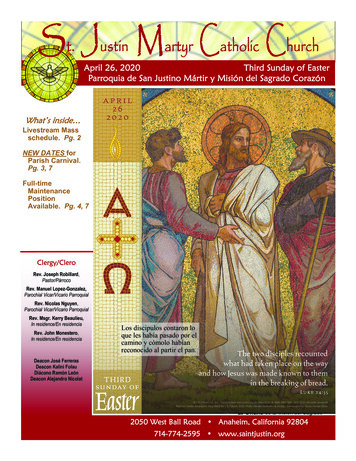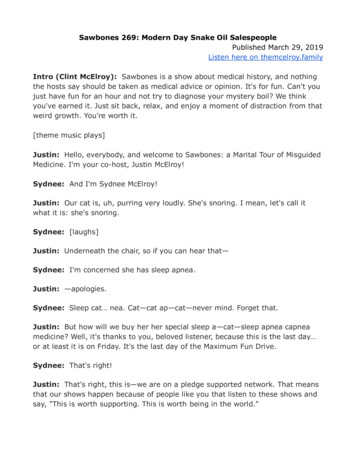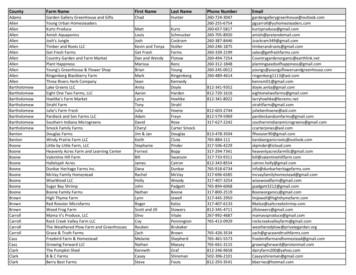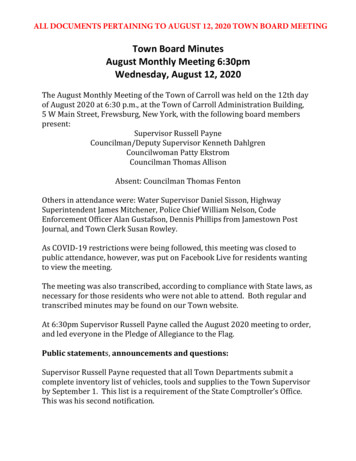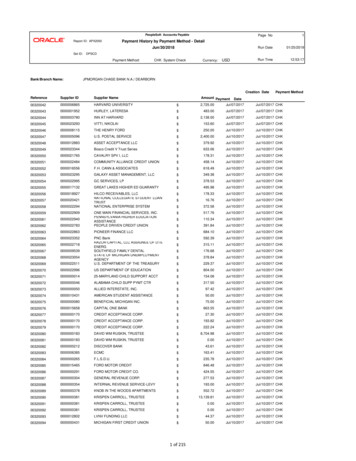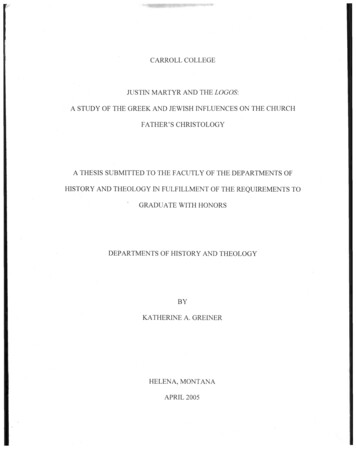
Transcription
CARROLL COLLEGEJUSTIN MARTYR AND THE LOGOS'.A STUDY OF THE GREEK AND JEWISH INFLUENCES ON THE CHURCHFATHER’S CHRISTOLOGYA THESIS SUBMITTED TO THE FACUTLY OF THE DEPARTMENTS OFHISTORY AND THEOLOGY IN FULFILLMENT OF THE REQUIREMENTS TOGRADUATE WITH HONORSDEPARTMENTS OF HISTORY AND THEOLOGYBYKATHERINE A. GREINERHELENA, MONTANAAPRIL 2005
SIGNATURE PAGEThis thesis for honors recognition has been approved for the Departments of History andTheology by:Annette Moran, Ph/S., C.S JKfijcfctfiReverend Jeremiah T. SullivanApril 15, 2005ii
ACKNOWLEDGEMENTSThis project would not have been possible without the help of many different,wonderful teachers, friends, and family. I would like to first thank the wonderful facultyof the history and theology departments at Carroll College for their incredible wisdom,guidance and expertise. I would like to thank specifically my director Dr. DavidMessenger for his patience, insight, and direction throughout this entire process. I wouldalso like to thank Sr. Annette Moran for introducing me to the wonderful world of theearly Christian community and her fabulous comments during the writing process andFather Jeremiah Sullivan who for four years has advised and taught me here at CarrollCollege, and who never ceases to amaze me with his compassion, humility, andbrilliance.I would also like to extend my deepest gratitude to my phenomenal parents,Richard and Sheryl Greiner, who through their endless love and support continue to sharewith me the joy of learning. Without their constant encouragement this thesis would nothave been possible.It is my prayer that we continue to constantly search and explore for the truth inits fullest, most profound existence, as Justin Martyr and the early Christian apologistsdid. May we all be receptive to the new depths, new heights, and new understandings thatHoly Spirit continues to open up to us.1iii
TABLE OF CONTENTSSignature Page.iiAcknowledgements. iiiIntroduction. . 1PAGECHAPTER1Cult and Cultures: The Roman Empire During the Time of Justin Martyr5Philosophy and ReligionThe Need for Christian Apologetics2Justin Martyr: Life, Philosophical Influences, and Works. 14Justin: His LifeGreek Influences On Justin’s ThoughtContact With and Response to Judaism3Justin Martyr and The Development of His Logos Christology.25Logos: The Greek And Jewish ConceptsPhilo’s Influence on JustinLogos: The New Testament Writings of Paul and JohnJustin’s Logos Christology4The Logos Christology Beyond Justin. 38Irenaeus and Origen: The Single-Stage TheoryThe Arian Controversy and BeyondChristology to the Present: The Debate ContinuesRoger Haight’s Spirit Christology: An Alternative ApproachJustin Martyr: An ExampleConclusion. 51Notes.53Works Cited. 60IV
INTRODUCTIONIn the first centuries following the life, death, and resurrection of Jesus Christ,Christianity began to emerge throughout the Roman Empire. The men and women whoconverted to Christianity began with their experiences and then interpreted andarticulated their experiences through their rituals, their understanding of the emergingscriptures, and their culture. These pioneering Christians and early Christian theologiansstruggled to define their own religious experiences within their own time. Justin Martyr,an early Church father is an example of one of these courageous and brilliant earlyChristian scholars. His Christological work helped to promote the dominating LogosChristology that has served to act as the metaphysical concept for the Christ experience.Christianity did not emerge as the dominant religion of the Roman Empire rightaway. In fact, the church was persecuted for the early centuries of its developmentfollowing the death of Jesus. With this persecution came the need for an articulation ofthe Christian faith, not only in order to explain and defend the faith to adversaries, but toalso build a cohesive, common doctrine amongst Christians throughout the empire.Christianity is a religion based on historical experience of the Christ event. Therefore, theearly followers of Christianity had to continually pass along the Christ story in order tokeep the faith growing and authentically emerging throughout the empire. This meantthat the church needed philosophically trained thinkers, ready to articulate the church, itsformation and its theology. From this need came the Apologists, an umbrella term for thetheologians of the time who worked hard to defend and explain the Christian faith to theskeptics. Their work, however, not only helped to preserve the church from external1
persecution, but also from internal misunderstandings of the faith. The apologists,through their devotion and commitment to the church and its development, were able toarticulate the Christ experience and thus gave a specific language to the Christiancommunity, allowing for unity and understanding between the growing groups ofChristians.1Christology is the discipline within theology that investigates the narrative ofChrist, the person of Jesus Christ, and attempts to articulate the experience of Christ inhistory and in the present. The Logos Christology was one of the earliest philosophicalunderstandings that was used by the early fathers to explain the experience of JesusChrist as both human and divine; specifically how God became a human being. TheLogos term was not new to the Christian community. It was a common Greekphilosophical idea explaining the reason and rationality throughout the world. In theJewish world, it meant the word, or spirit of God, acting in the world. It is present in bothPauline theology as well as John’s Gospel as a scriptural expression. The Christianfathers understood this term to fit their experience of Christ. Christ was the reason,rationality, word and spirit of God made flesh and manifested in the human being ofJesus of Nazareth. Jesus Christ is the Logos who through the incarnation became human.The present worldview has shifted from the classical, Platonic philosophical viewto a more modern and postmodern conceptualization of our world. The Logos concept,because of its culturally conditioned theological focus, may no longer work as our onlyconcept to articulate how God became human in the person of Jesus Christ of Nazareth.The current challenge is not new. The philosophical movements since the eighteenthcentury have challenged the Logos Christology. Since the Enlightenment, historical2
consciousness has challenged certain Christian beliefs concerning the life, death, andresurrection of Christ. Because of this new emphasis on the historical and its challenge toChristianity, there has been a movement within Christianity to reevaluate the historicalJesus, repainting the narrative of the human Jesus. The shift thus turned the question fromhow God became human, as the Logos concept addresses, to how was Jesus Christ God?This subtle, yet very different approach to the constant Christological question of Christ’sdivinity and humanity inevitably involves new concepts and new language.The incarnation, since the scientific revolution, has been challenged and werequire new language to combat the challenges Christology is facing today. It is not theintention or meaning of the concepts that needs to be changed, it is the language. But inorder to confront and change traditional concepts, we must know how they weredeveloped, adopted and how they were understood if we are to stay true to the richness oftheir meanings.3 We can use the methodologies of the early church fathers to show ushow Christianity was built within a certain historical milieu and continually needs to bereexamined and rearticulated in order to maintain its relevancy within the postmodern,more pluralistic world of today. Karl Rahner discusses this in his discussion onMysterium Ecclesiae. He states,The document [Mysterium Ecclesiae] establishes first of all transmission of divinerevelation is impeded by historical situations. Even dogmatic formulations areconditioned by terms which are dependent on the language and total situation of aparticular era of thought. . . . The declaration says explicitly that the Church’sMagisterium can under certain circumstances enunciate dogmatic truths in termswhich bear traces of ‘the changeable conceptions of a given epoch.’4Therefore it is important to explore the works of the early church fathers, not onlyfor their wisdom but for their example as theologians. They allowed their understanding3
of their worldview and culture to help give them the language to articulate their Christianexperience. As Rahner also notes, we need to interpret the early church and what cameout of the early church in order for it to speak and help us today. “We must acknowledgeclassical Christology and yet see that it is not the only possible one, in the sense that therecould be no other orthodox statements of a Christological kind.”5Justin Martyr’s works serve as theological examples of what needs to be engagedand interpreted. Through exploration of his influences and his works, we can come tounderstand his worldview and how he developed his theological ideas. His developmentof the Logos Christology can serve as a model for how we can use our own philosophicalunderstanding and language to articulate the Christ event, opening the door to newinterpretations and new Christologies that more fully open the person of Christ and thegospel experience to our time. This thesis will explore the world of Justin, the influenceson Justin, the works of Justin and will end with an analysis on how Justin’s theologicalapproach can serve as an example today.4
CHAPTER ONE:CULTS AND CULTURES: THE ROMAN EMPIRE DURING THE TIME OFJUSTIN MARTYRChristianity began to emerge as a legitimate minority religion during the secondcentury, attracting the attention of different political, intellectual and religiousmovements throughout the Roman Empire. Affected by the political, social and culturalworld of the second century Roman Empire, Christianity began to adopt terms and ideasin order to articulate more eloquently and cohesively the message of the Christian church.This chapter will explore the philosophical and religious influences the Roman Empireand cultures of the Roman Empire had on the development of the Christian church.Politically the second century CE marked the golden period of the RomanEmpire. Under the rule of the “Five Good Emperors“, the Empire experienced stability,extended boundaries, and secured relative peace compared to earlier times. Whatspecifically underlay the success of these “Five Good Emperors” was the fact that eachsuccessor was chosen based on merit, not blood line. Each emperor was able to determinewhich man was to follow after his death. Thus, political stability ensued throughout thesecond century not necessarily because of static rulers, but because of a series oflegitimate emperors, chosen by skill, who ruled with authority, and whose legitimacy wasunchallenged. Although this did not completely remedy the chasm between the senateand the emperorship, it did help to spark some political stability between the two bodiesof government.6 Such stability was a necessary component in Christianity’s growth.Philosophy and ReligionThe second century, because of the political stability, saw a rise in urban life5
around the Roman Empire. More roads were being built, allowing more trade andcommerce throughout the empire, especially in the port cities. Thus trade expanded to theoutermost areas of the Roman Empire. With the growth of urban areas, not only did thetrade of materials grow, but the trade of ideas throughout the Empire as well.7 This timeperiod was remarkable for the increasing amount of philosophical scholarship throughoutthe Roman Empire. The growth in philosophical schools flourished, especially under thereign of the philosopher king, Marcus Aurelius, a stoic who wrote the famousphilosophical work, Meditations. It was this growing influence of philosophy thatcontributed to the development of Christianity during the second century.The theology and philosophy of Christianity did not develop overnight nor in acultural vacuum. Christianity grew slowly affecting and affected by the Roman Empire’sphilosophical and religious milieu. Although it is dangerous to say that Christianity wassimply an amalgamation of the different forms of thought that were dominating thereligious and philosophical landscape of Rome, it is important to note the effects thedifferent sects and learning communities had upon the development and certainly thearticulation of Christian teaching and theology. By coming into contact with thesedifferent elements, Christianity was forced to reject, accept, or adapt different modes ofthinking about gods, wisdom, reason, and human beings.There existed two dominating philosophies in the Roman Empire during thesecond century: Platonic thought and Stoicism. Platonism began to reemerge around thefirst century. Reemphasizing the teachings of Plato, this school of philosophy discussedthe idea of a transcendent reality that exists in the world of forms. Platonism stresseseternal life and the existence of an eternal creator. One of the most influential Platonists6
during the second century was the Jewish philosopher, Philo, who was writing around 7080CE. His work had an incredible influence on the early church fathers, especially due tohis idea of the Tri-Unitarian God. Platonism greatly influenced the development ofChristianity because it offered a compatible philosophy to Christianity’s understanding ofeternal and transcendent reality. It was a compelling philosophy that helped toincorporate Christianity into the Roman world.8Stoicism had been developed by Zeno in the mid-3rd century BCE. There are threemain parts to stoicism: physics, ethics and logic. The Stoics’ main idea was that the souland body, while different, could not be understood separate from one another; thereforein this philosophy there is a focus on the reason of the body. Although not cynics,because there is a devotion to logic and other human beings, the Stoics move away fromthe Platonic and Aristotelian notion of forms and the goodness of the soul.9 The Stoicswere very suspicious of emotions, or “passions” understanding emotions and passions tobe the enemy of reason.10 This philosophy seemed to permeate the Roman Empire at thetime of the rise of Christianity, especially through the Meditations of Marcus Aurelius.Both Platonism and Stoicism played significant roles in the development of earlyChristianity. They will be discussed more in depth in a later chapter, but it is importantto note that Christianity was in contact with different philosophies and often appliedGreek concepts to Christian theology, like Justin did with the idea of the Logos as Christ.Religion also played an important role in the everyday lives of Roman citizens,especially the less educated peasants. The Roman State religion was reintroduced byAugustus (27BCE-14CE) after the formation of the Roman Empire in order to promote asense of unity between the different cultural and religious groups of the Roman Empire.7
One major example of the importance of state religion took place in 17 BCE withAugustus’ Secular Games. The intent of the games was to purify the Roman people, eachday sacrificing to different gods. On the final day there was a large sacrifice to Apollo,Augustus’ favorite god. As Prudence Jones and Nigel Pennick point out in their work, AHistory of Pagan Europe,. the ceremonies cleansed and unified the Roman people,then placed them under the protection of three sets of divinities. .It was a masterlyceremony, welding what was to become the Empire into a cohesive whole for the nexttwo hundred years, and it was to provide the backbone of the old order during thedisintegration of the two centuries after that.”11 Having a Roman pantheon that demandedhomage from all citizens helped to promote yet another form of unity. Everyone desiredto be Roman, and when in Rome do as the Romans do: pray to their gods. The existenceof a major state religion was one of the driving forces behind the persecution and purgesof Christian groups. Christians refused to worship the Roman gods and this refusal, in theRoman mind, spit in the face of Roman unity. Thus the persecution of Christianity, atleast the emperor’s persecutions, were more political rather than theological.Another consequence of state religion was that the different sects and pagan cults,which had dominated the different regions and cultures of the territories now belongingto the Roman Empire, began to disappear, blending into the religious pantheon of theRoman gods. At the same time, there was a rising sense of opposition to the Roman statereligion, and the people began to find it lacking in personal relationship with the gods.Roman gods were not personal gods, but rather, as Frend points out, fitting to the modelof a state religion.12 Therefore many sought after different religions with more of a focuson salvation and eternal life.8
The personal relationships people desired with the gods came from theirinvolvement in the mystery religions. These mystery cults mainly reemerged from pastreligious traditions that had dominated the cultural landscape of the territories of Rome,such as Persia and Egypt.One of the main cults that dominated the religious sphere in Rome was the cult ofIsis. This cult’s roots were in an Egyptian myth that then developed into a moresophisticated religion in Rome, dignifying the idea of a goddess as mother and nurturer.The Cult of Isis was very popular among different groups of women, as Isis was thecentral goddess from which life sprung.13 During the second century, the Zoroastrianreligion of Mithras emerged in full force. The Cult of Mithras was one of the mostpopular Mystery cults in the Roman Empire, especially considering its intense secrecyand denial of women into the cult. With the idea of a god of evil and a god of good, thecult of Mithras encompassed the popular ideas of the dualistic nature in the thoughtprocess that the Gnostics, especially sects like Manichaeism favored.At first these different mystery religions were not regarded with favor by theRoman government for similar reasons that Christianity and Judaism were deemedsuspicious: they endangered the ability of the state to control a very important part ofculture. Also, because Christianity shared a few commonalities with some of the conceptsin mystery cults, like the idea of resurrection, Christians had to disassociate themselvesfrom the mystery religions and also had to compete with and differ from the mysteryreligions. Similar ritual practices, like the ceremonial meals, also posed a challenge. Thecontact Christianity had with the mystery cults forced the Christian church to decide whatand who they were, and what separated them from the popular pagan cults.149
Gnosticism was beginning to emerge in the second century. Gnosticism, as ageneral term, applied to different religious groups that borrowed bits and pieces ofdifferent religious and philosophical traditions in order to fit their own religiousunderstanding of the universe. Although there were many different groups, Gnostics didshare similar religious views. For example Gnosticism was dualistic: there was a goodforce and an equally evil force at work in the universe. This evil force was derived fromthe material world, while the good lay in the spiritual. Focused on the idea of salvation,Gnostic groups understood salvation as the elevation of the spirit from the evil materialworld. But the Gnostics contended that human beings could not do this on their own, andthus a mediator was required, and this was where Christ fit the Gnostic religious ideasvery well. Thus, the Gnostic groups adopted the person of Christ, yet they misrepresentedthe Christian doctrine, and because of this came into direct conflict with Christianity.15There are three main problems Christianity had with the Gnostics. First of all, theidea of the material world as the creation of “evil” went completely against the Judeo-Christian idea of the goodness of creation and the creator. Another point of contentionwas the lack of acknowledgement of the resurrection of the body. The Gnostics thoughtthe body was just a shell, and not only unimportant and unnecessary, but exactly themedium through which we ignore our potential. Thinking of the body as just a shell led toa Christological problem Christianity had to defend. The Gnostics did not believe in thecomplete incarnation of Christ, a core doctrine of Christianity. Instead it was onlyChrist’s body, not Christ himself, who was crucified and so the death and suffering werenot possible. This went completely against the Christian doctrine, and yet the Gnosticswere claiming it to be Christian doctrine.1610
It would be an oversight to deny the importance Judaism continued to have uponChristianity during the second century. The Jews for the most part lived in relative peacewithin the Roman Empire, due in large part to their willingness to be a separate group,not outwardly proselytizing. Judaism did, however, find itself in conflict withChristianity. Despite this conflict Christianity still was very much affected by the rootsthat it shared with Judaism. During the second century, the Old Testament, or the Jewishscriptures, were challenged in light of Christian teachings and the question was asked ifChristianity required the Old Testament in order to understand the teachings of Christ.The Church Fathers, Justin included, deeply rooted in the Jewish context, valuedthe content of the Old Testament because of its parallels to the Christ story in the NewTestament. It was necessary in order to give meaning to the New Testament. Jesus couldnot be understood outside of his experience as a Jew in a Jewish culture; therefore, therewas recognition of the need for the Old Testament. This caused major conflict for theJewish population as their sacred scriptures were being manipulated, it seemed to them,in order to fit this new blasphemous religion. Christianity reduced the importance of thelaw, especially circumcision, and law is central in Judaism.17 There was also theargument that Judaism and Christianity were competing for Gentile converts and theirhostility towards one another stemmed from this competition.18 It is important torecognize that although the Christians and Jews did not get along, the Christian churchwas deeply affected by the Jewish tradition and heritage.19 Different philosophical ideaswithin Judaism also affected Christianity, and those, such as the work of Philo ofAlexandria will be addressed later on.Thus, the philosophical and religious milieu Christianity found itself in and the11
challenges that Christianity had to respond to forced church fathers to articulate anddefend the faith. Known as the Apologists, these different writers helped to solidifyChristianity’s role as a legitimate religion in the Roman Empire.The Need for Christian ApologeticsThe second century proved to be a challenging time for the early Christian church.Persecuted and challenged not only by the Jewish communities, the church experiencedlack of toleration from the popular sphere of the Roman world, and also had to deal withmisrepresentations of the Christian faith from different Gnostic sects. It was during thistumultuous time that early Christian theologians began to explain and defend the faith.These Apologists, or defenders, played a very important part in the development of theChurch. Not only did the Apologists defend the faith against the unbelievers, theymanaged to open the doors to the philosophical and theological exploration andexplanation of the beliefs of the Christian church. They helped solidify certain doctrineand understandings of the Gospels for the Christian community itself.During the reign of the “Five Good Emperors,” there was no specific law againstChristianity. However, popular sentiment was quite clearly against the church. Becauseof their refusal to submit to the laws of the emperor and worship of the Roman gods, theChristians were feared and labeled as heretics and the cause of any natural catastrophes.20Thus during this time many church leaders were executed by the Roman government.Under the reign of the Philosopher king, Marcus Aurelius, Christians were persecutedand executed at alarming rates. Both Bishop Polycarp in Smyrna and Justin Martyr inRome were executed in 165CE. The time of prosperity and stability for Rome was a state12
of turmoil for the Christian minority in the Empire.In response to the evident misunderstandings and apparent lack of toleration forthe Christian faith, many different church leaders and fathers began to write and articulatethe theology and philosophy of Christianity within the context of the Roman and Greekworld. Although their works may not have made any impact upon the leadership of theRoman Empire, they did help to stabilize and solidify the church and the people of thechurch during a time of chaos. Some Apologists, like Justin and Irenaeus, utilized theirunderstandings of neo-Platonism in order to illustrate not only Christianity’scompatibility with Greek thought, but also the completeness of the philosophy foundwithin Jesus Christ. The apologists also combated the accusations of being a cult religionthat sprung from misconceptions of the similarities with mystery cults by reaffirmingChristianity’s parent religion of Judaism, using the Old Testament allegorically to createparallels with the New Testament. The Apologists also began to write down thesacramental practices in order to explain and create unity within the church’sunderstanding of the different sacraments, especially baptism. The articulation of thesacraments also illustrated that the sacramental practices were not seditious or immoral.The second century was a time of turmoil for the Christian church, and yet it isarguable that without the writings coming out of this period, Christianity may not havesubsequently developed as it did. The persecutions and misunderstandings of the secondcentury forced the apologists to explain the faith: not just to their adversaries, but to theChristian community as a whole. This contributed to a more unified, though certainly notuniform, understanding of the teachings of Christ and the role the church was to play inthe lives of the Christian community.13C0REn'ELI6)MWW(iTOuCOLLEGE
CHAPTER TWOJUSTIN MARTYR: LIFE, PHILOSOPHICAL INFLUENCES, AND WORKSThe importance of the early Apologists and their effect on the development of thechurch is phenomenal. The Apologists helped, whether intentionally or not, to guide anddirect future theologians through terminology, doctrine, and faith. Justin Martyr was oneof the first to use Greek philosophy to explain Christianity.21 Using Platonic thought andhis understanding of the Christian truth, Justin addressed not only the pagan culturepersecuting the Christians, but also used his knowledge of the scriptures and philosophyto present an argument and discussion addressing the Jewish tradition.Justin: His LifeMost of the information available about Justin comes to us through the threereliable works attributed to him: his first two apologies, and most importantly the semiautobiographical Dialogue With Trypho. Other information about Justin comes from thefamous Christian historian of the third century, Eusebius. Therefore, what is known aboutJustin is limited, although not impossible to decipher. His birth date is unknown, but itcould be estimated around the year 100-110 CE.22 He was bom near the biblical Shechemknown as Flavius Neapolis in Palestine to a wealthy middle-class family.23 This isevident because his apparent education indicates wealth, yet perhaps not status. Althoughborn near Palestine, Justin was not Jewish, nor is it evident that he knew much aboutJewish thought in his early life. He was steeped in the philosophical milieu of the timeearly on in his life, and this contributed to his later vocation as a defender of the Christian14
church against the pagan philosophies. In fact it was Justin’s ability to converse andarticulate Christian ideas in philosophical terms that helped to begin the construction ofbridges between the Christian faith and the philosophies of the time.Justin was a philosopher. He was forever searching for the truth that he knewexisted and that he wished to understand. He had an eclectic philosophical background inthat he tried many different schools as a young man. Justin studied with a group of Stoics,Peripatetics, the Pythagoreans and the Platonists.24 Finding them unsatisfactory, Justincontinued to search for a philosophy that fit what he was looking for. He found that“true” philosophy in Christianity and, according to sources, continued to wear theclothing of a philosopher even after his conversion to Christianity.25 Yet it is important tonote that during his conversion Justin was studying with the Platonists and had foundPlatonic thought stimulating and resonating. This accounts for how Justin understood andexplained Christian philosophy later o
history and in the present. The Logos Christology was one of the earliest philosophical understandings that was used by the early fathers to explain the experience of Jesus Christ as both human and divine; specifically how God became a human being. The Logos term was not new to the Christian community. It was a common Greek


